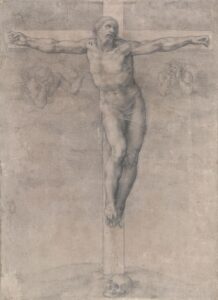EMQA 01/03/24
Thank you to everyone who has asked that the EMQA format be brought back. We Cover:
- E- An Emergency Topic or ECG
- M- A Major/Medical Topic
- Q- A Famous Quote to inspire us all
- A- Art: Because Life is not all about Medicine.
Here’s what I’ve got for you this Week
- An ECG Challenge: Is this VT? One simple thing to remember in the Wide Complex Rhythm.
- The Surgical Airway : An ENT Surgeons Perspective: A Free EMCORE Lecture for you to watch
- A Quote by Michelangelo, that inspires us to reach higher.
- The Art of Michelangelo and his famous Pietà. Why would his signature on the sculpture, nearly get him beheaded?
E: ECG of The Week
A patient has presented to the emergency department with palpitations. The ECG shows a wide complex rhythm. Is this VT? Is there a simple way to work it out?
The first rule I always apply is the ‘120’ rule, which is part of the 120CRAM formula, that I use.
What does the patient’s ECG show? Is this VT? Decide, then look at the answer to find out more.

The Answer
The ‘120 rule’ says that it can’t be VT unless it’s faster than 120 beats per minute and wider than 120ms (but not too wide). Part of this 120 rule, is that it must be a regular rhythm. Monomorphic VT is exquisitely regular, as it’s a re-entry circuit.
This ECG looks like a wide complex tachycardia, with a LBBB morphology. The rate is only about 84 beats per minute, so it’s probably not VT. The other key finding here is that it is irregularly irregular.
It’s AF + LBBB.
Look at the ECG below. Is this VT?

Answer
It’s wide with a rate is >120, so we can start thinking of VT. The waveforms are not all the same. This is where you can be fooled into thinking that this is AF. This is because we see capture and fusion beats in this ECG. Don’t be fooled. This is VT.

Go to ECG of the Week and view 4 more cases of wide complex tachycardia. Which are VT?
M: Medical Topic Review: The Surgical Airway: An ENT Perspective
Below is a free video lecture for you to watch from EMCORE 2018. It’s about Surgical Airway……… but from an ENT Surgeon’s (Dr Charles Giddings) perspective. Enjoy.
Q: Quote
The greater danger for most of us lies not in setting our aim too high and falling short, but in setting our aim too low and achieving our mark
Michaelangelo Buonarroti
Art: Because It’s not all about Medicine.
Michelangelo Buonarroti (1475-1564) Architect, Painter, Sculptor.
If you are coming to EMCORE London, read below for the incredible Michelangelo Exhibition that will be on at this time in London.
Michelangelo’s works include the Sistine Chapel, the statue of David, The Pietà, The dome of St Peter’s Basilica, the Palazzo Farnesse and so many more.


A Focus on The Pietà.
The Pietà was commissioned by the French cardinal Jean Bilheres de Lagraulas to decorate his tomb in St. Peter’s Basilica in Rome/Italy.
The contract of commission for the Pietà to Michelangelo expressly stated: that “Michelangelo shall complete said work within one year and that it shall be more beautiful than any work in marble to be seen in Rome today, and such that no master of our own time shall be able to produce a better“.
Michelangelo’s signature appears on the sash across the Virgin Mary’s chest. Why would it be there given that the artist’s initials are already on the statue? When inspected closely by experts, this signature was carved after the final polishing and was not of the same quality as the rest of the sculpture.
The story is that when the sculpture was unveiled, much to Michelangelo’s disappointment, people said that the work had to be of a famous Roman artist, not one from Florence ie., Michelangelo. That night Michelangelo entered the cathedral and inscribed his name hastily on the sash ‘Michelangelo Buonarroti of Florence did this work‘. He escaped capture at the time, but had to be pardoned by the Pope himself. Michelangelo regretted the act and swore to never sign another one of his works.
This year you can attend an exhibition: Michelangelo; The Last Decades at the British Museum: (2nd May – 28th July). This exhibition looks at the last 30 years of Michelangelo’s life, from ages 59 to 89. This part of his life began following a return to Rome, where he was summoned by Pope Clement VII to paint a fresco of the Last Judgment in the Sistine Chapel.
He was a fiercely independent artist who mainly worked alone, but we see in this later work, his age and ailments resulting in the need for collaboration. It was a time when the artist, who was devout Catholic, was obviously concerned about his own soul and his own salvation. His works at this time demonstrate how he explored his faith, through studies such as that of the ‘Crucifixion’.
I personally am excited about this exhibition and look forward to spending time taking in the works by this inspirational artist.
If you’re in London 2nd May – 28th July, you can book a ticket to this exhibition at the British Museum.
SEE YOU AT EMCORE



JOIN US FOR OUR OTHER COURSES
The Cardiac Online Course
Primary Exam Course
Written Fellowship Course
The OSCE Course
JOIN US at Cardiac Bootcamp Pre-Conference Workshop
COMPLETED BY THOUSANDS OF DOCTORS, NURSES AND PARAMEDICS
Thankyou always for all your hard work.
“The knowledge you take into your shift DOES matter” Peter Kas

Due to the volume of emails from thousands of weekly readers, I am unable to read and reply to them all.
Forward this to someone.
Received this from someone? Join the thousands of weekly readers JOIN NOW
Keep in touch with what’s happening at the emcore conferences by joining us on social media @emcoreshow.











